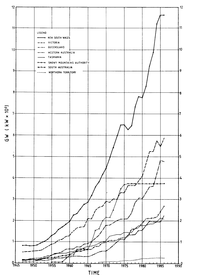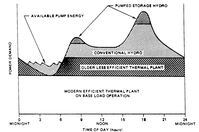


Chapter 11
I The Present Energy Economy
II Australian Energy Consumption
III Research And Development
IV Coal
V Oil And Natural Gas
VI Solar Energy
VII Nuclear Energy
VIII Bagasse Firewood And Other Biomass
IX Electric Power Generation And Distribution electric Power Generation And Distribution
i Types of generating stations
ii Transmission and distribution
iii System load control
iv Australian manufacturing in the power industry
v Queensland
vi New South Wales
vii Victoria
viii Tasmania
ix South Australia
x Western Australia
xi Northern Territory
xii Australian Capital Territory
xiii The Snowy Mountains Scheme
X Manufactured Gas
XI Industrial Process Heat
Sources
Index
Search
Help
Contact us

electric Power Generation And Distribution
Types of generating stations
Nearly all electricity supply in Australia is now derived from steam turbine driven generators, fired by either coal or gas. The boilers are fired with black coal in Queensland and NSW, and brown coal in Victoria, and sub-bituminous coal in South Australia and Western Australia. Only in a few isolated communities are diesel driven generators in use today. Northern Territory having no coal deposits, initially relied on imported bunker oil at great expense, and is now depending on natural gas piped 1500 km from the Amadeus Basin. South Australia first fired with natural gas nearly 20 years ago and Western Australia is beginning to use its North-West Shelf gas supplies for generation.The vast deposits of coal of various kinds in Australia will provide the main source of electricity generation for many years to come. At present the highest quality coal is exported in about the same quantity as is used for home generation and steel making. There are enormous deposits of lesser grade coals, however, the extent of which is far from fully established, especially in South Australia; these deposits suffer from many disadvantages, including very high ash and alkali content, low calorific value, very long haulage distances to major cities, and in some cases at extreme depths.
Hydro-electric power has been developed in many areas of Australia, and it can be said that few sites remain for economic use. The principal locations of hydro power are in Tasmania, and in the Snowy Mountains region of NSW, together with the Victorian Alps and parts of North Queensland.
As the demand for electricity grew, the expansion of many small power stations became clearly uneconomic, and groups of isolated systems were interconnected and fed from new central power stations. This process evolved into the Statewide systems which have been the normal pattern since the 1950s in all States. The rapid post-war growth of installed generating capacity in Australia is shown in Fig. 21.

In 1974 the first major use of pumped-storage hydro power was commissioned in the Snowy Mountains Scheme (1500 MW at Tumut 3 power station), and was followed in 1978 by the 240 MW Shoalhaven Scheme in NSW, which also provided additional inflow for the Sydney water supply. Then in 1984 the 500 MW Wivenhoe pumped storage plant began operation in Queensland. These developments take advantage of the fact that after midnight and at weekends the steam driven generators are not fully loaded, and can provide power for water pumping at very low rates. The stored water in an upper reservoir can then be used for power generation at the time of highest system demand, when the value of the electrical energy is greatest (See Fig. 22). Notwithstanding that the turn-round efficiency of the pumping and generating cycle is only about 75 per cent, the added value per kWh makes such schemes very attractive. Other States are examining possible developments of similar kind, and there is little doubt that more such stations will be built. Apart from the peak load generation facility, other benefits are available from pumped storage stations, such as rapid assistance at times of lost generation elsewhere, or in the event of sudden increases in system demand; a source of the latter is the sudden jump in demand when a popular television program ends, and it is of interest that this phenomenon in Britain had its greatest effect (adding over 2300 MW) when the final episode of the Australian series The Thorn Birds ended.

Organisations in Australian Science at Work - Australian Consumers' Association; Snowy Mountains Scheme
 |
Australian Academy of Technological Sciences and Engineering |  |
© 1988 Print Edition pages 823 - 824, Online Edition 2000
Published by Australian Science and Technology Heritage Centre, using the Web Academic Resource Publisher
http://www.austehc.unimelb.edu.au/tia/800.html